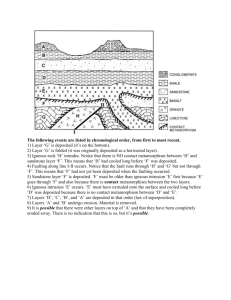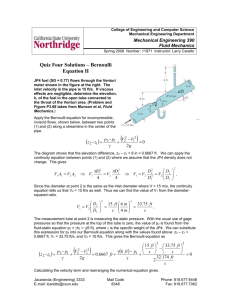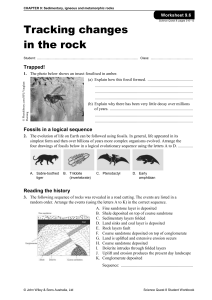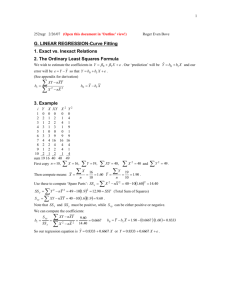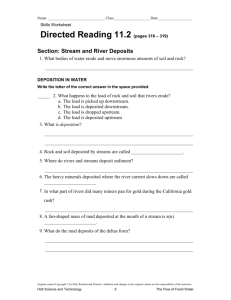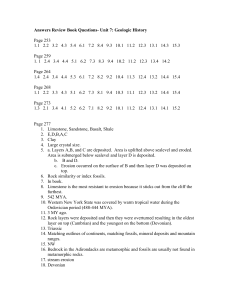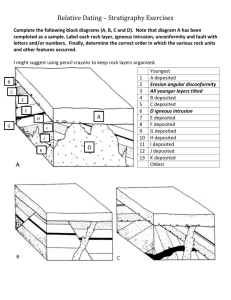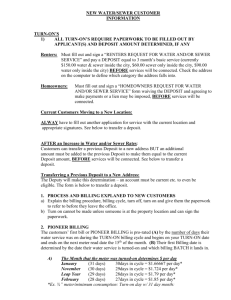Concept 8. Future Value (FV) Example
advertisement
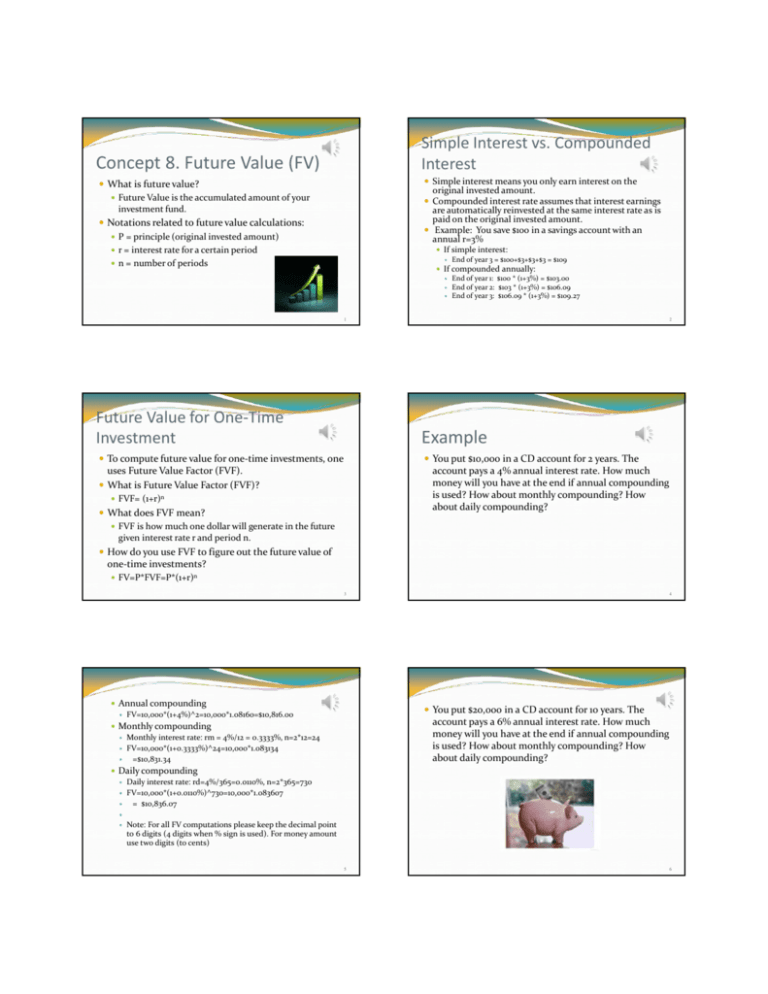
Simple Interest vs. Compounded Interest Concept 8. Future Value (FV) Simple interest means you only earn interest on the What is future value? Future Value is the accumulated amount of your investment fund. original invested amount. Compounded interest rate assumes that interest earnings are automatically reinvested at the same interest rate as is paid on the original invested amount. Example: You save $100 in a savings account with an annual r=3% Notations related to future value calculations: P = principle (original invested amount) r = interest rate for a certain period n = number of periods If simple interest: End of year 3 = $100+$3+$3+$3 = $109 If compounded annually: End of year 1: $100 * (1+3%) = $103.00 End of year 2: $103 * (1+3%) = $106.09 End of year 3: $106.09 * (1+3%) = $109.27 1 Future Value for One-Time Investment 2 Example To compute future value for one-time investments, one You put $10,000 in a CD account for 2 years. The uses Future Value Factor (FVF). What is Future Value Factor (FVF)? account pays a 4% annual interest rate. How much money will you have at the end if annual compounding is used? How about monthly compounding? How about daily compounding? FVF= (1+r)n What does FVF mean? FVF is how much one dollar will generate in the future given interest rate r and period n. How do you use FVF to figure out the future value of one-time investments? FV=P*FVF=P*(1+r)n 3 Annual compounding FV=10,000*(1+4%)^2=10,000*1.08160=$10,816.00 4 You put $20,000 in a CD account for 10 years. The account pays a 6% annual interest rate. How much money will you have at the end if annual compounding is used? How about monthly compounding? How about daily compounding? Monthly compounding Monthly interest rate: rm = 4%/12 = 0.3333%, n=2*12=24 FV=10,000*(1+0.3333%)^24=10,000*1.083134 =$10,831.34 Daily compounding Daily interest rate: rd=4%/365=0.0110%, n=2*365=730 FV=10,000*(1+0.0110%)^730=10,000*1.083607 = $10,836.07 Note: For all FV computations please keep the decimal point to 6 digits (4 digits when % sign is used). For money amount use two digits (to cents) 5 6 FV of Periodical Investments Annual compounding What is periodical investments? Periodical investments are multiple investments that are made at certain time intervals. FV=20,000*(1+6%)^10=20,000*1.790848=$35816.95 Monthly compounding Monthly interest rate: rm = 6%/12 = 0.5%, n=10*12=120 FV=20,000*(1+0.5%)^120=20,000*1.819397=$36387.93 How to calculate the future value of periodical investments? It is probably best illustrated using an example. Daily compounding Daily interest rate: rd=6%/365=0.0164%, n=10*365=3650 FV=20,000*(1+0.0164%)^3650=20,000*1.822029= $36440.58 7 8 Beginning of the month calculation (deposit money on the first day of every month): Monthly interest rate rm= 8%/12=0.6667% FV of $100 deposited on Jan. 1= $100 * (1+0.6667%)^12 = $108.30 FV of $100 deposited on Feb. 1= $100 * (1+0.6667%)^11 = $107.58 FV of $100 deposited on March 1=$100 * (1+0.6667%)^10 = $106.87 FV of $100 deposited on April 1 = $100 * (1+0.6667%)^9 = $106.16 FV of $100 deposited on May 1= $100 * (1+0.6667%)^8 = $105.46 FV of $100 deposited on June 1= $100 * (1+0.6667%)^7 = $104.76 FV of $100 deposited on July 1= $100 * (1+0.6667%)^6 = $104.07 FV of $100 deposited on Aug. 1= $100 * (1+0.6667%)^5 = $103.38 FV of $100 deposited on Sept. 1= $100 * (1+0.6667%)^4 = $102.69 FV of $100 deposited on Oct. 1= $100 * (1+0.6667%)^3 = $102.01 FV of $100 deposited on Nov. 1= $100 * (1+0.6667%)^2 = $101.34 FV of $100 deposited on Dec. 1= $100 * (1+0.6667%)^1 = $100.67 Total FV = Sum of the FVs of the 12 periodical payments = $1253.29 Example Suppose you have decided to save some money to pay for a vacation. You can afford to save $100 a month. You put the money in a money market account which pays an 8% annual interest rate, compounded monthly. How much money will you have at the end of the 12th month? Note: we can treat this as 12 separate $100 investments that are in the bank for different length of time. Note: With beginning of the month (BOM) calculation the last deposit, deposited on Dec. 1, earns one month of interest. 9 End of the month calculation (deposit money on the last day of every month): Monthly interest rate rm= 8%/12=0.6667% FV of $100 deposited on Jan. 31= $100 * (1+0.6667%)^11 = $107.58 FV of $100 deposited on Feb. 28= $100 * (1+0.6667%)^10 = $106.87 FV of $100 deposited on March 31=$100 * (1+0.6667%)^9 =$106.16 FV of $100 deposited on April 30 = $100 * (1+0.6667%)^8 = $105.46 FV of $100 deposited on May 31= $100 * (1+0.6667%)^7 = $104.76 FV of $100 deposited on June 30= $100 * (1+0.6667%)^6 = $104.07 FV of $100 deposited on July 31= $100 * (1+0.6667%)^5 = $103.38 FV of $100 deposited on Aug. 31= $100 * (1+0.6667%)^4 = $102.69 FV of $100 deposited on Sept. 30= $100 * (1+0.6667%)^3 = $102.01 FV of $100 deposited on Oct. 31= $100 * (1+0.6667%)^2 = $101.34 FV of $100 deposited on Nov. 30= $100 * (1+0.6667%)^1 = $100.67 FV of $100 deposited on Dec. 31= $100 * (1+0.6667%)^0 = $100.00 Total FV = Sum of the FV of the 12 periodical payments = $1244.99 10 Are there simpler ways of calculating FV for periodic investments? If the monthly payments are equal, then we can simplify the problem by using Future Value Factor Sum (FVFS) With end of the month calculation, the last deposit, which is deposited on Dec. 31, does not earn any interest. In fact, every deposit earns one month less of interest compared to the beginning of month situation. 11 12 Future Value Factor Sum (FVFS) BOM or EOM Beginning of the month (BOM) formula The difference between Beginning of the Month (BOM) and End of the Month (EOM) is that with BOM the last investment earns interest for one period, while with EOM the last investment does not earn interest because it goes in and out of the account at the same time. Appendix FVFS Table shows EOM. Although, in most relevant cases of FVFS applications BOM is likely to be more appropriate. (1 + r ) n +1 − 1 FVFS = (1 + r ) n + (1 + r ) n −1 + ... + (1 + r )1 = −1 r End of the month (EOM) formula FVFS = (1 + r ) n −1 + (1 + r ) n − 2 ... + (1 + r ) 0 = (1 + r ) n − 1 r 13 FV for Periodical Payments 14 Now we use FVFS to solve the previous example FV=Pp*FVFS problem. Beginning of the month: Where Pp=amount of periodical payments FV = Pp × FVFS (r = 0.6667%, n = 12, BOM ) (1 + r ) n +1 − 1 − 1) r (1 + 0.6667%)12+1 − 1 = 100 × ( − 1) 0.6667% = 100 ×12.5330 = 1253.30 = Pp × ( 15 16 Applications of FV End of the month: Compute the FV of saving $200 on the first day of each month for 6 months (withdraw at the end of the sixth month) at 12% annual interest rate, monthly compounding FV = Pp × FVFS (r = 0.6667%, n = 12, EOM ) (1 + r ) n − 1 ) r (1 + 0.6667%)12 − 1 = 100 × ( ) 0.6667% = 100 ×12.4499 = 1244.99 = Pp × ( 17 18 n=6 months, monthly r=12%/12=1%=0.01, beginning of the month calculation Compute the FV of saving $200 on the last day of each FV = Pp × FVFS (r = 1%, n = 6, BOM ) month for 6 months (withdraw at the end of the sixth month) at 12% annual interest rate, monthly compounding. n +1 (1 + r ) − 1 − 1) r (1 + 1%) 6+1 − 1 = 200 × ( − 1) 1% = 200 × 6.213535 = 1242.71 = Pp × ( 19 n=6 months, monthly r=12%/12=1%=0.01, end 20 Suppose you save $500 on the first day of each month of the month calculation for 6 months at 12% annual interest rate, compounded monthly, and then only put $200 on the first day of each month starting from the 7th month for another 6 months at the same interest rate. How much money will you have at the end of the 12th month? FV = Pp × FVFS (r = 0.6667%, n = 12, EOM ) (1 + r ) n − 1 ) r 6 (1 + 1%) − 1 = 200 × ( ) 1% = 200 × 6.152015 = 1230.40 = Pp × ( 21 This is a more complicated scenario. You have to treat 22 Investment 2 this as two investments. Investment one is a periodical investment of $500 per month for 6 month. After 6 months whatever amount there is will be treated as a one-time investment for another six months. Investment two is a periodical investment of $200 each month for 6 months. The total is the sum of these two investments. Investment 1: Next 6 months: Pp=200, monthly r=12%/12=1%=0.01, n=6 FV2 = Pp × FVFS (r = 1%, n = 6, BOM ) (1 + r ) n +1 − 1 − 1) r 6 +1 (1 + 1%) − 1 = 200 × ( − 1) 1% = 200 × 6.213535 = 1242.71 = Pp × ( FV1 = Pp × FVFS (r = 1%, n = 6, BOM ) × (1 + r )12− n (1 + r ) n+1 − 1 − 1) × (1 + r )12− n r (1 + 1%) 6+1 − 1 = 500 × ( − 1) × (1 + 1%)12−6 1% = 500 × 6.213535×1.061520 = 3297.90 = Pp × ( Total FV 23 FV=FV1+FV2=3297.90+1242.71=4540.61 24 This is an application of FVFS because this is Saving for Vacation related to periodical payments Mary is planning on saving some money for her next vacation. Her goal is to have $2000 saved after one year. If she decides to put an equal amount of money in a bank savings account every month on the first day, and the interest rate is 6% annually, how much should she save every month, if interest is compounded monthly? 25 Denote the monthly saving amount as M Monthly interest rate r = 6%/12 = 0.5% M × FVFS (r = 0.5%, n = 12, BOM ) = 2,000, M = 2,000 FVFS (r = 0.5%, n = 12, BOM ) = 2,000 (1 + 0.5%)12+1 − 1 −1 0.5% = 2,000 = 161.33 12.397240 26
